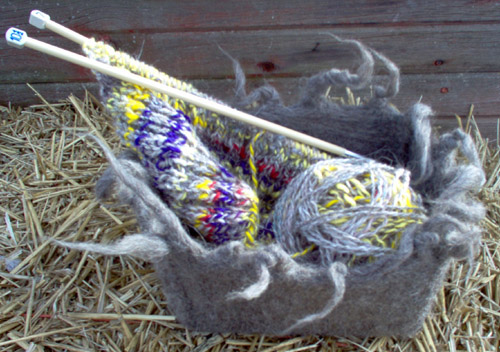
 I've
been knitting for about a month now,
but for the record, I really, really
did not want to knit. First of all
it's so, you know, cool now.
Not that I personally know anyone
who knits besides my mom, my aunt,
and my grandmother, but I get Bust
magazine. I've heard about the trendy
yarn cafés opening up in the
cities, and, yes, I've seen all the
swanky little yarn shops popping up
here and there.
I've
been knitting for about a month now,
but for the record, I really, really
did not want to knit. First of all
it's so, you know, cool now.
Not that I personally know anyone
who knits besides my mom, my aunt,
and my grandmother, but I get Bust
magazine. I've heard about the trendy
yarn cafés opening up in the
cities, and, yes, I've seen all the
swanky little yarn shops popping up
here and there.Secondly,
I tried knitting once, and it did
not go well. And last year, even after
I found my childhood stash of large
needles (10, 10.5, 13, and 15), dutifully
stored by my mother "just in case,"
I knew I would never need them. Still,
I couldn't bring myself to throw them
out.
Besides, I
was needle-felting at the time. Now
there was something not everyone
was into. It involved dangerous-looking
little tools for poking fibers together,
required no patterns, and allowed
lots of room for whimsy and/or error.
But alas, there
was knitting in my future.
It's my mother-in-law's
fault I had llamas on my mind in the first
place. And it's the llamas' fault I began
to knit.
Here's how it happened,
starting with the llamas. Well, beginning
a little before the llamas.
My NYC born-and-raised
spouse and I had just moved to Michigan
(to a 20-acre farm, no less) from a fourth-floor
walk-up in Hoboken, NJ. My in-laws were
visiting from Queens for the first time
and we took them to visit a small wool mill.
Our tour guide,
brimming with enthusiasm, ushered us through
two floors of bustling activity, and we
watched wooly locks wash, drip, dry, card,
spin, and spool. On the top floor of the
little mill, a cadre of women stitched fluffy
batting into colorful quilts and comforters.
I was mesmerized.
So was my mother-in-law,
who, I should mention, is an inveterate
crafter. Not only did I marry into a crafty
family, I come from one myself. One grandmother
quilts, paints, and crochets; my other grandmother
was a brilliant knitter and seamstress who
made most of my clothes when I was growing
up.
My mother
also sews and knits, but her one attempt
to teach me, when I was in my early
teens, resulted in a shabby (yet definitely
not chic) sleeveless sweater patched
together from two big, saggy squares.
Instead of yarn, I'd chosen some sort
of gauzy cotton strips that were the
color (and nearly the texture) of
ace bandages. The end result, clumsily
knitted on size 15 needles and full
of unintentional holes, looked like
something from Pat Benatar's "Love
is a Battlefield" video. Not in a
good way.
Though I liked my
ace bandage sweater, and wore it until it
completely disintegrated from poor craftsmanship,
it had taken me endless months to knit,
and I didn't have that kind of patience.
I racked knitting up on that list of "Things
I've Tried Once and Am Not Good At," along
with bowling and tying flies. (Admittedly,
I now enjoy the occasional bowl, and the
latter is something I might try again someday.)
I recalled this
story at the fiber mill when our guide asked
if was a knitter. "Oh, no, I'm not, but
someday, I'd love to have some sheep. My
aunt and uncle have a big flock of sheep,
and my aunt spins, and knits from her own
fiber."
I paused, lost in
the lanolin smell of the mill and my shepherdess
fantasy. "But I can't knit. I tried it once,
and just don't have the patience for it."
By this point
our guide had led us into the mill's
small gift shop at the tour's end.
It was replete with handspun yarns,
knitted items, quilted comforters,
and felted bags and hats. I'd never
seen needle felting done before.
"Oh, it's so easy!"
our enthusiastic guide-cum-salesperson assured
me, showing me the keenly sharp needles
tipped with tiny barbs that interlock fibers
into felt. "Anyone can do it."
Here is the crucial
point at which I might have missed fiber-artisthood
altogether: the point at which my mother-in-law
bought me a small felting kit. Although
I had no inkling of it at the time, it was
one of those truly life-altering moments.
And here I stumbled not only into a future
with fiber, but with llamas. And I was soon
to cross the threshold to knitting.
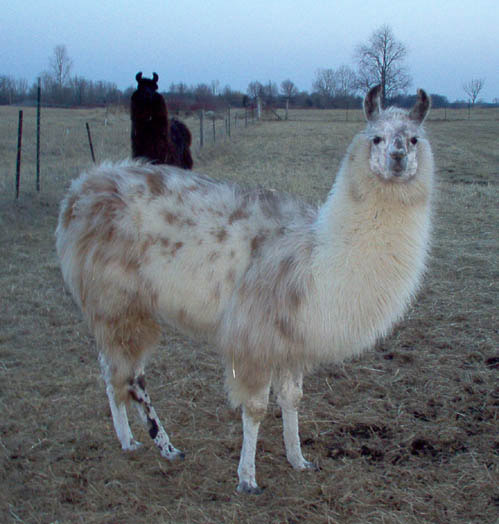

As we were leaving
the mill, the guide handed me a slim magazine
for the Michigan Fiber Festival. "It's coming
up in August. They have fiber animals, workshops,
lots of exhibitors -- it's fantastic."
Now, not only do
I come from a family of crafters (and one
full of carpenters and cabinet-makers and
handymen as well) but I've always been an
artist in search of a medium. In high school
I tried drama, dance, and creative writing.
In college it was sculpture, graphic design,
textiles, architecture, photography -- just
one or two courses in each, until the head
of the art department told me I had "no
focus." With senior year looming, I half-heartedly
invented my own major, somehow explaining
to the faculty (and myself) that the smattering
of courses I had taken constituted a "coherent
body of study."
After graduation
I worked in art museums and art galleries
-- becoming what Julia Cameron calls
a "shadow artist" in The Artist's
Way
-- in other words, someone who works
with and for artists, but not allowing
herself to be an artist. I was even
in a band for a while. But nothing
felt quite right; nothing seemed quite
like me.
I had been dreaming
of sheep, but when I went to the Fiber Festival,
it was the llamas I fell in love with. Conveniently,
the Fiberfest was soon followed by East
Lansing's annual Lamafest. And soon after,
we visited a nearby farm and came home with
two handsome young llamas.
Llannie is a bittersweet
chocolate color, and Graty is an appaloosa,
whose fleece spins up into a beautiful heathery
color. But what I didn't know about llamas
is that they are extremely intelligent,
watchful animals, with enormous, soulful
eyes. Much like cats, they cooperate if
and when they feel like it. But they do
enjoy being walked around the farm on leads,
like big shaggy dogs.
Everyone's first
question is, "Do they spit?"
Well, yes, they
do, but ours spit but only at each other.
Actually, Llannie spits at Graty, and I've
never seen Graty spit. Neither of them have
ever spit at us (although you can get caught
in the crossfire, if you're not careful).
They spend most
of the day grazing their pasture, and in
the evening they kush down on their knees,
just like camels. They need to be sheared
once a year, and then you have all of this
gorgeous fleece!
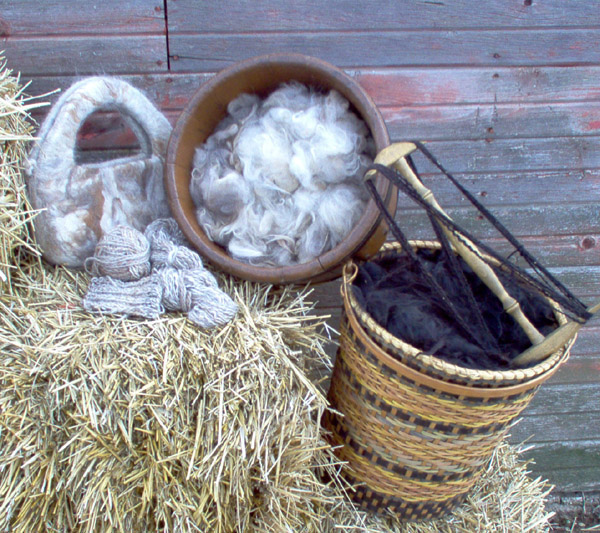 |
| Graty
and Llannie's fleece, a felted Graty-bag,
and llama yarns |
Unlike sheep's wool,
llama fiber has virtually no lanolin or
grease, so it doesn't need to be washed
before use. (People with wool allergies
generally find llama and alpaca fiber hypoallergenic.)
It is a hollow fiber, and that's why it
is so unbelievably warm (and light!). In
fact, due to its hollow core, llama fiber
is technically considered hair, not wool
at all. Because of its limited elasticity
(hence, little "memory"), llama is often
blended with sheep's wool for felting or
spinning.
Like alpaca, llama
fiber is in the luxury/specialty fiber class.
It is measured in microns, a system that
passes fibers through a laser cell to determine
their diameter. A micron is 1/25,400 of
an inch, or 1/1,000 of a millimeter. The
average human hair can measure from anywhere
from 60 to 100 microns. Alpaca fiber is
a mere 22 to 28 microns in diameter; similarly,
llama averages 25 to 30 microns.
(For further
comparison, mohair measures 25-45
microns, merino wool 12-20 microns,
cashmere 15-19 microns and angora
rabbit 10-12 microns.)
Alpaca is
a popular luxury fiber, but don't
discount llama as a beautiful fleece
to work with. Llamas come in 22 natural
colors, and their fiber is strong,
extremely soft, and offers an excellent
weight-to-warmth ratio. And as you
can see, it can be just as soft as
alpaca.
So the llamas
joined our family, and I began needle-felting.
My first project was a pair of mittens
(I used my hands as the pattern),
then a pair of slippers, then two
purses, then a basket. More slippers,
more baskets.
But inevitably,
when I told people I was working with fiber,
they asked if I spin or knit.
And I'd launch into
the story about my Pat Benatar sweater.
"Oh," the knitters
would gently reassure me, "I bet if you
tried knitting again it would come back
to you."
(I see now that
knitting is a program of attraction, not
promotion.)
In my defense, I'd
explain how much I love having llamas, how
I'd finally found my medium in fiber, how
much I enjoy needle-felting. "It's the perfect
medium," I'd tell anyone who would listen.
"I love soft furry things, I love animals,
and you can do anything with it!" (And this
without yet being able to spin or knit.)
This fall,
my 87-year-old grandmother decided
that she wanted to learn to spin,
and my mother and I agreed to take
a few spinning lessons with her. (How
cool, a three-generational spinning
class, we thought.)
So I began learning
to spin.
And then, there
it was: I had yarn.
My spinning instructor,
kind and very wise soul that she is, insisted
that we each make something with the first
skein of yarn we spun.
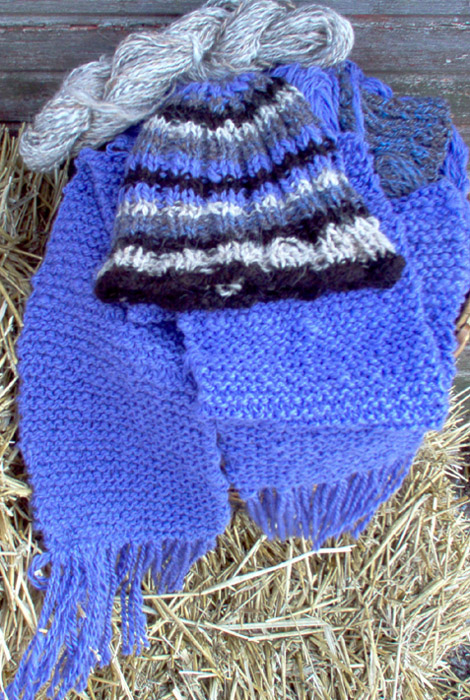 |
| My
first scarf and hat, with Graty and
Llannie yarn |
She expected me
to actually make something with my lumpy,
patchy, puffy skein of what I'll very politely
call "novelty" yarn. But hey, I spun that
skein of lavender yarn my very own self,
and I was insanely proud of it.
Well, I decided
I was going to knit a scarf.
Me, knit?
Well, I had to!
I couldn't let that fantastic skein of spun-by-my-own-hands
yarn go to waste, could I?
And so my patient
mother showed me how to knit again, just
as she had twenty years ago.
The needles felt
oddly familiar in my fingers. My brain didn't
quite remember, but my fingers did.
Cast on? Doesn't
that go like this? Oh! Oh yeah, this goes
like this...the yarn does this...and suddenly,
I was knitting.
Now I can't spin
fast enough to have sufficient yarn to knit
with. I admit I'm sticking to relatively
simple projects (yes, I'm still easily frustrated,
and not terribly patient) -- but then again,
I've only been knitting for a month. But
in a month I've knitted a scarf (yes, from
my crazy lavender yarn!) and five hats -- all
from my self-spun yarn.
And proudly, I can
cross knitting off the list of "Things I've
Tried Once and Am Not Good At."
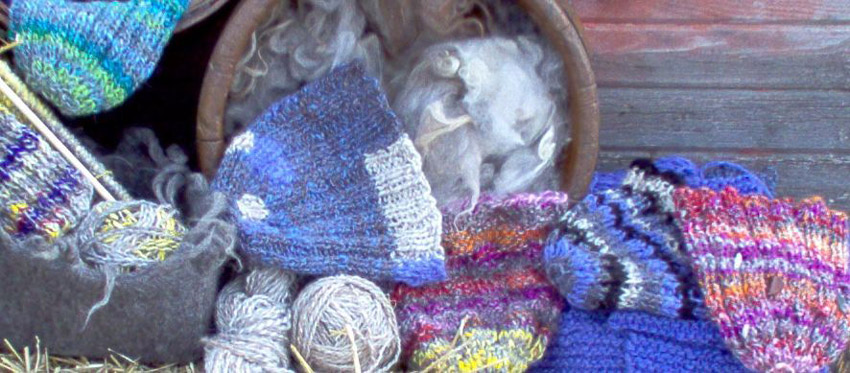
SOURCES/RESOURCES
Michigan
Fiber Festival:
http://www.marrhaven.com/mff.html
Lamafest:
http://www.lamafest.com/
Information
on the micron system and comparative
micron diameters:
http://www.llamapaedia.com/wool/testing.html
http://www.llamapaedia.com/wool/evaluation.html
(from the New South
Wales Department of Education and
Training/Curriculum Planning Framework
and Programming Support Site, "Stage
5: Agricultural Technology, Measuring
Wool Fibre Diameter")
Basic information
on llama fiber garnered from: "Storey's
Guide to Raising Llamas," by Gale
Birutta (North Adams, MA: Storey Publishing,
1997), esp. pp. 246-9,
and
http://www.llamapaedia.com/wool/character.html
Note:
There were minor discrepancies between
the two micron charts I consulted,
but neither gave sample sizes for
each breed or described their data
collection (i.e. fiber from hind quarters
would vary from finer belly hairs).
Given that these charts both gave
ranges, I averaged them together.
An interesting
point for spinners and knitters is
that any fiber measuring over 30 microns
is considered to have "prickle" factor,
or the scratchy quality associated
with coarser fibers. (See http://www.ymccoll.com/micron_reports.html)

